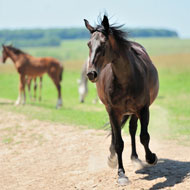New insights into SI joint pain

The research suggests scintigraphy alone is not a reliable method of diagnosing SI joint pain.
Pioneering research by the Animal Health Trust (AHT) offers insights into the prevalence and characteristics of sacroiliac (SI) joint region pain and how it relates to lameness in horses.
This is the first large-scale study of its kind and it is hoped the findings will help vets and horse owners to recognise the clinical signs.
According to the research, the clinical signs of SI joint region pain are worse when horses are ridden. This highlights the importance of examining horses under saddle where possible to observe the severity and breadth of the clinical signs.
Another key finding was that diagnostic analgesia using a safe, non-specific nerve block could significantly reduce clinical signs.
Signs indicative of SI joint region pain were: bucking and kicking, particularly in canter; a bunny-hopping type canter; stiff, stilted canter; spontaneously breaking from canter to trot; and being reluctant to canter.
Blocking the SI joint in diagnostic investigations could offer crucial information in horses showing these signs, according to AHT.
The research also suggests scintigraphy alone is not a reliable method of diagnosing SI joint pain - just 42 per cent of the horses with a positive response to SI joint pain had abnormal radiopharmaceutical uptake.
However, researchers said the use of scintigraphy and ultrasonography in conjunction with an SI block can provide additional information in some cases.
The majority of the horses involved in the study had SI joint region pain and lameness of the hind limbs. In some horses, removing the source of pain in the lame limb resulted in a clear improvement.
However, ridden exercise highlighted the persistence of another source of pain, which in some cases was worse after eradicating the lameness.
AHT said this highlights the importance of observing ridden exercise in trot and canter when assessing lameness.
Lead author Sue Dyson added: "Assessing the effect of treatment of the SI joints is not an effective method of diagnosis; the use of nerve blocks is much more reliable."



 The BSAVA has opened submissions for the BSAVA Clinical Research Abstracts 2026.
The BSAVA has opened submissions for the BSAVA Clinical Research Abstracts 2026.